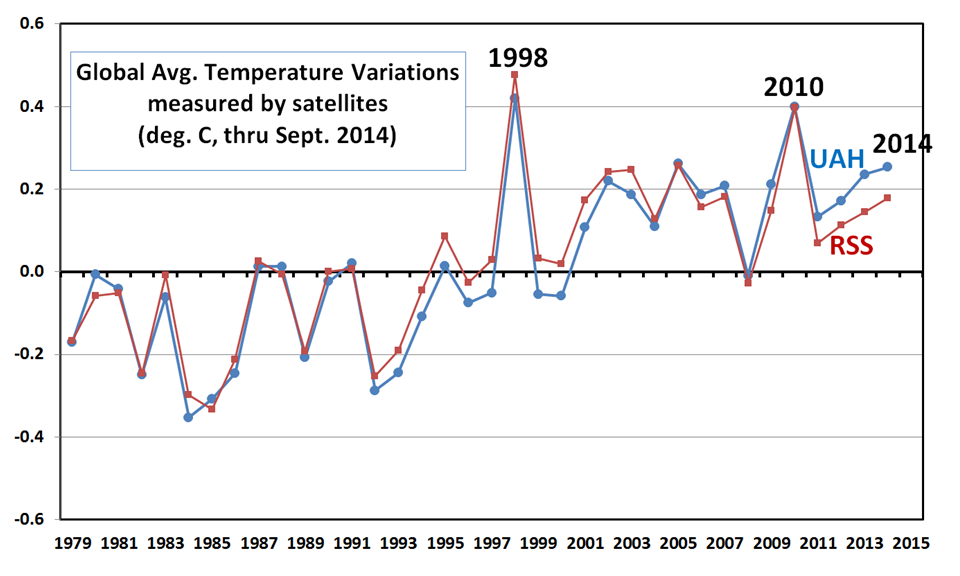Much is being made of the “global” surface thermometer data, which three-quarters the way through 2014 is now suggesting the global average this year will be the warmest in the modern instrumental record.
I claim 2014 won’t be the warmest global-average year on record.
..if for no other reason than this: thermometers cannot measure global averages — only satellites can. The satellite instruments measure nearly every cubic kilometer – hell, every cubic inch — of the lower atmosphere on a daily basis. You can travel hundreds if not thousands of kilometers without finding a thermometer nearby.
(And even if 2014 or 2015 turns out to be the warmest, this is not a cause for concern…more about that later).
The two main research groups tracking global lower-tropospheric temperatures (our UAH group, and the Remote Sensing Systems [RSS] group) show 2014 lagging significantly behind 2010 and especially 1998:
With only 3 months left in the year, there is no realistic way for 2014 to set a record in the satellite data.
Granted, the satellites are less good at sampling right near the poles, but compared to the very sparse data from the thermometer network we are in fat city coverage-wise with the satellite data.
In my opinion, though, a bigger problem than the spotty sampling of the thermometer data is the endless adjustment game applied to the thermometer data. The thermometer network is made up of a patchwork of non-research quality instruments that were never made to monitor long-term temperature changes to tenths or hundredths of a degree, and the huge data voids around the world are either ignored or in-filled with fictitious data.
Furthermore, land-based thermometers are placed where people live, and people build stuff, often replacing cooling vegetation with manmade structures that cause an artificial warming (urban heat island, UHI) effect right around the thermometer. The data adjustment processes in place cannot reliably remove the UHI effect because it can’t be distinguished from real global warming.
Satellite microwave radiometers, however, are equipped with laboratory-calibrated platinum resistance thermometers, which have demonstrated stability to thousandths of a degree over many years, and which are used to continuously calibrate the satellite instruments once every 8 seconds. The satellite measurements still have residual calibration effects that must be adjusted for, but these are usually on the order of hundredths of a degree, rather than tenths or whole degrees in the case of ground-based thermometers.
And, it is of continuing amusement to us that the global warming skeptic community now tracks the RSS satellite product rather than our UAH dataset. RSS was originally supposed to provide a quality check on our product (a worthy and necessary goal) and was heralded by the global warming alarmist community. But since RSS shows a slight cooling trend since the 1998 super El Nino, and the UAH dataset doesn’t, it is more referenced by the skeptic community now. Too funny.
In the meantime, the alarmists will continue to use the outdated, spotty, and heavily-massaged thermometer data to support their case. For a group that trumpets the high-tech climate modeling effort used to guide energy policy — models which have failed to forecast (or even hindcast!) the lack of warming in recent years — they sure do cling bitterly to whatever will support their case.
As British economist Ronald Coase once said, “If you torture the data long enough, it will confess to anything.”
So, why are the surface thermometer data used to the exclusion of our best technology — satellites — when tracking global temperatures? Because they better support the narrative of a dangerously warming planet.
Except, as the public can tell, the changes in global temperature aren’t even on their radar screen (sorry for the metaphor).
Of course, 2015 could still set a record if the current El Nino ever gets its act together. But I’m predicting it won’t.
Which brings me to my second point. If global temperatures were slowly rising at, say, a hundredth of a degree per year and we didn’t have cool La nina or warm El Nino years, then every year would be a new record warm year.
But so what?
It’s the amount of temperature rise that matters. And for a planet where all forms of life experience much wider swings in temperature than “global warming” is producing, which might be 1 deg. C so far, those life forms — including the ones who vote — really don’t care that much. We are arguing over the significance of hundredths of a degree, which no one can actually feel.
Not surprisingly, the effects on severe weather are also unmeasurable …despite what some creative-writing “journalists” are trying to get you to believe. Severe weather varies tremendously, especially on a local basis, and to worry that the average (whatever than means) might change slightly is a total misplacement of emphasis.
Besides, once you consider that there’s nothing substantial we can do about the global warming “problem” in the near term, short of plunging humanity into a new economic Dark Age and killing millions of people in the process, its a wonder that climate is even on the list of the public’s concerns, let alone at the bottom of the list.

 Home/Blog
Home/Blog




